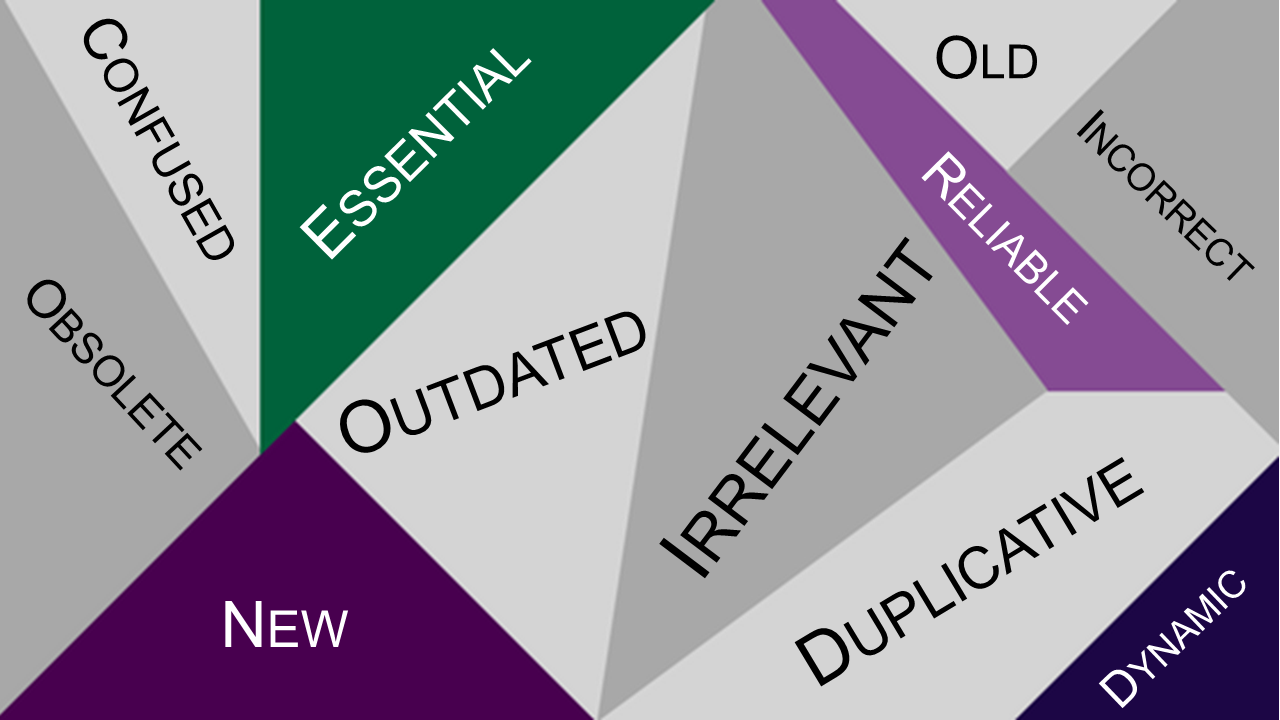
Over my years of consulting, I’ve had the opportunity to strategize, design, and conduct a number of content migration efforts. This is typically in the context of broader content management, document management, or knowledge base redesign or refresh efforts.
In many of these cases, the goal is for multiple legacy systems to be decommissioned, with the appropriate content migrated to the new system. Such efforts generally begin by conducting a content analysis, where, amongst other things, the location, amount, and utilization of the legacy content is assessed.
Such content analyses often reveal a massive amount of legacy content, commonly measured in millions of documents. It is at this point where a combination of panic, malaise, and hopelessness hits some organizations. We can help you avoid this, however, with some core content migration best practices that can help you to prioritize your content, focus on highest value content, and clean your systems in the process.
EK’s past efforts have yielded a critical data point for content migration. On average, no more than 20-30% of an organization’s content is ever migrated to the new system. This is not to say the old content should be deleted (we can discuss records management another time), but simply that it doesn’t need to be moved to a new system for one of several reasons. Typically, this is because:
- Content is outdated or obsolete. A recent content analysis, for instance, found 47 versions of a single policy. Another found a floor plan for a building that had been sold a decade earlier. Yet another included the cafeteria “specials” menu for every day over the last twenty years.
- Content is duplicate or near duplicate. Many legacy systems are full of iterated versions of documents that have since been finalized. For example, for a new client looking to migrate their document management system, we discovered they’d been holding over 100 different versions of a single marketing plan. This commonly occurs when an individual saves a document locally, and then uploads it as a fresh document instead of leveraging version control capabilities. In organizations that are consolidating from multiple systems to one, we also commonly see content duplicated across these legacy systems.
- Content is simply incorrect. Going beyond the concept of outdated policies or old forms, many legacy systems include information that is plain wrong. In a recent effort for a web design company, their knowledge base still included a best practices document on designing for Internet Explorer 7 as the gold standard. We also commonly find documents and directories that reference individuals who no longer work at the organization and haven’t for some time.
- No one cares. Lastly, many organizations inevitably possess a great deal of content that users no longer care about. Meeting memos from years past, news about people no longer employed (or living), and sales plans for products that are no longer sold all fall into this category. The concept of a help desk knowledge base serves to paint the picture. If there’s an answer to a question that no one has asked for a decade, it likely doesn’t need to be in your production system.
This cleaning of content, eliminating the detritus accumulated over years, is not simple. However, if approached correctly, it will not only make your content migration effort exponentially easier, it will also improve your findability while minimizing the risk and liability associated with poor content management.
To guide these efforts, I created the acronym N.E.R.D. When faced with a daunting content migration effort, organizations should focus on that content which is:
- New – Simple sorting will reveal the newest version of documents and the latest thoughts from your experts.
- Essential – Company policies and legal restraints will guide that which is necessary for regulatory compliance and your business users can help to identify business critical information.
- Reliable – When faced with a myriad of old, outdated, and obsolete content, ensure you’re migrating the “right” versions and leave the rest to the archives.
- Dynamic – Recognize the content that is fleeting, such as news, memos, and meeting minutes. The latest of these documents demonstrate dynamism and tend to be critical, but their value wanes quickly, as does their need to be migrated.
Basic user and system analytics can go a long way to helping you identify your NERDy content. Engagement with your end users, critical for a variety of other reasons as well in such an endeavor, can fill in the gaps. As a result, your organization will not only succeed in its content migration efforts, you will end up with a cleaner, tighter, and more trustworthy collection of content, and that will result in happier and more productive end users.
Need help getting NERDy? We’re here to help.
